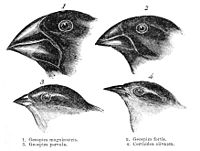
Photo from wikipedia
In the Arctic’s Beaufort Sea, the rate of sea-level rise over the last two decades has been an order of magnitude greater than that of its global mean. This rapid… Click to show full abstract
In the Arctic’s Beaufort Sea, the rate of sea-level rise over the last two decades has been an order of magnitude greater than that of its global mean. This rapid regional sea-level rise is mainly a halosteric change, reflecting an increase in Beaufort Sea’s freshwater content comparable to that associated with the Great Salinity Anomaly of the 1970s in the North Atlantic Ocean. Here we provide a new perspective of these Beaufort Sea variations by quantifying their causal mechanisms from 1992 to 2017 using a global, data-constrained ocean and sea-ice estimate of the Estimating the Circulation and Climate of the Ocean (ECCO) consortium. Our analysis reveals wind and sea-ice jointly driving the variations. Seasonal variation mainly reflects near-surface change due to annual melting and freezing of sea-ice, while interannual change extends deeper and mostly relates to wind-driven Ekman transport. Increasing wind stress and sea-ice melt are, however, equally important for decadal change that dominates the overall variation. Strengthening anticyclonic wind stress surrounding the Beaufort Sea intensifies the ocean’s lateral Ekman convergence of relatively fresh near-surface waters. The strengthening stress also enhances convergence of sea-ice and ocean heat that increase the amount of Beaufort Sea’s net sea-ice melt. The enhanced significance at longer time-scales of sea-ice melt relative to direct wind forcing can be attributed to ocean’s advection and mixing of melt-water being slower than its dynamic adjustment to mechanical perturbations. The adjustments’ difference implies that the sea-ice-melt-driven diabatic change will persist longer than the direct wind-driven kinematic anomaly.
Journal Title: Journal of Physical Oceanography
Year Published: 2021
Link to full text (if available)
Share on Social Media: Sign Up to like & get
recommendations!